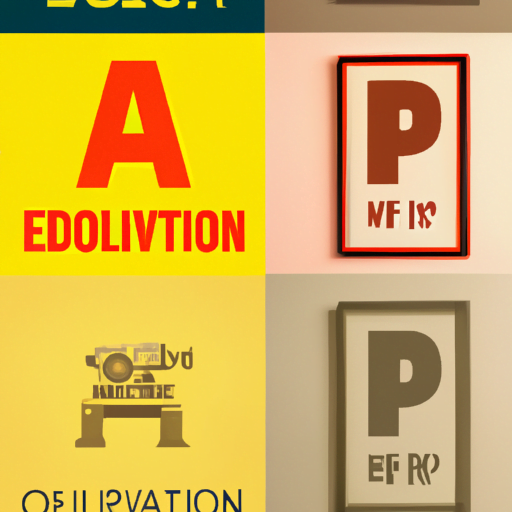Table of Contents
The Evolution of Typography: From Print to Digital

Typography, the art and technique of arranging type, has undergone a remarkable transformation over the centuries. From the early days of print to the digital age, typography has adapted and evolved to meet the changing needs of communication and design. In this article, we will explore the fascinating journey of typography, examining its historical roots, key milestones, and the impact of digital technology on this ancient art form.
The Origins of Typography
Typography can trace its origins back to ancient civilizations, where early forms of writing and symbols were carved into stone or clay tablets. The invention of movable type in ancient China during the Song Dynasty (960-1279 AD) marked a significant milestone in the history of typography. The Chinese developed a system of individual characters carved onto wooden blocks, which could be arranged and rearranged to create text.
However, it was Johannes Gutenberg’s invention of the printing press in the 15th century that revolutionized the world of typography. Gutenberg’s press allowed for the mass production of books, making knowledge more accessible and affordable. The printing press also standardized the use of typefaces, leading to the development of various typographic styles.
The Birth of Typefaces
With the rise of printing, the need for standardized typefaces became apparent. Typefaces are sets of characters with consistent design attributes, such as size, weight, and style. The first typefaces were modeled after handwritten scripts, imitating the calligraphy of scribes. These typefaces, known as blackletter or gothic, were widely used in Europe during the medieval period.
In the 18th century, a new style of typeface emerged known as transitional. This style, exemplified by the work of John Baskerville, featured sharper, more refined letterforms. The transitional style laid the foundation for the modern typefaces that we use today.
During the 19th century, the Industrial Revolution brought about significant advancements in typography. The introduction of mechanized typesetting machines, such as the Linotype and Monotype systems, enabled faster and more efficient typesetting. These machines allowed for the mass production of printed materials, including newspapers, magazines, and books.
The Rise of Digital Typography
The advent of computers in the 20th century marked a new era for typography. With the introduction of digital technology, typography became more versatile and accessible than ever before. The development of desktop publishing software, such as Adobe InDesign and QuarkXPress, revolutionized the design industry.
One of the key advantages of digital typography is the ability to create and manipulate typefaces with ease. Designers can now experiment with a vast array of typefaces, adjusting their size, weight, and spacing to achieve the desired effect. This flexibility has opened up new possibilities for creative expression in design.
Another significant development in digital typography is the emergence of web fonts. In the early days of the internet, web designers were limited to a small set of system fonts that were available across different operating systems. This restriction severely limited the creative possibilities for web design.
However, with the introduction of web fonts, designers can now use a wide range of typefaces on websites, ensuring consistent typography across different devices and platforms. Web fonts are hosted on remote servers and can be easily integrated into web pages, providing a seamless user experience.
The Impact of Digital Typography
The rise of digital typography has had a profound impact on various aspects of communication and design. Here are some key areas where digital typography has made a significant difference:
- Accessibility: Digital typography has made printed materials more accessible to people with visual impairments. With the use of screen readers and assistive technologies, individuals can now access and consume content in various formats.
- Branding: Typography plays a crucial role in brand identity. Digital typography has allowed companies to create unique and recognizable brand identities through the use of custom typefaces. Examples include the distinctive typography of brands like Coca-Cola and Google.
- User Experience: Good typography enhances the user experience by making content more readable and engaging. Digital typography has enabled designers to experiment with different typefaces, sizes, and spacing to optimize readability and legibility.
- Responsive Design: With the proliferation of mobile devices, responsive design has become essential. Digital typography allows designers to adapt the typography of a website or application to different screen sizes and resolutions, ensuring a consistent and enjoyable user experience across devices.
The Future of Typography
As technology continues to advance, typography will undoubtedly continue to evolve. Here are some trends and developments that we can expect to see in the future:
- Variable Fonts: Variable fonts are a new type of font format that allows for dynamic variation in weight, width, and other attributes. This technology opens up new possibilities for responsive typography and customization.
- Augmented Reality (AR) and Virtual Reality (VR): AR and VR technologies offer exciting opportunities for typography. Imagine walking through a virtual environment where typography is an integral part of the experience, interacting with the user in new and innovative ways.
- Artificial Intelligence (AI): AI-powered design tools can analyze vast amounts of data and generate typographic recommendations based on user preferences and design trends. These tools can assist designers in making informed decisions and streamline the design process.
Conclusion
The evolution of typography from print to digital has been a remarkable journey. From the invention of movable type to the rise of digital technology, typography has adapted and transformed to meet the changing needs of communication and design. Digital typography has brought unprecedented flexibility and accessibility, revolutionizing the way we create and consume content. As we look to the future, typography will continue to evolve, driven by advancements in technology and the ever-changing landscape of design.


